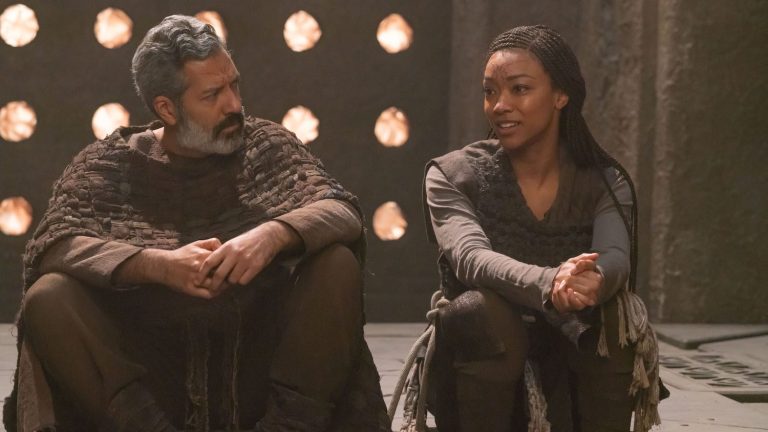Star Trek: Discovery Season 5 Episode 6 Review – Whistlespeak
Discovery’s search for the Progenitors’ technology takes the crew to a pre-Warp planet and runs afoul of the Prime Directive.

This Star Trek: Discovery review contains spoilers.
Star Trek: Discovery Season 5 Episode 6
Star Trek: Discovery (mostly) gets its final season back on track after last week’s flashback-filled snoozefest, but Michael and company’s search for the next clue hits a snag when the trail leads to a pre-Warp planet whose lack of technology makes accessing it more of a challenge than anyone expected. It’s a shift that comes as a welcome relief—the best part of this more adventure-oriented season has been its old-fashioned space explorer feel as Burnham and her crew bounce from planet to planet (or random interdimensional pocket of space). And it’s nice to finally get back to that, even if the planet Halem’no isn’t quite as exciting a side quest as some of us (read: me) may have wanted it to be.
The planet is largely arid, with a habitable zone that’s been created thanks to the work of Denobulan scientist Hitoroshi Kreel. A weather tower disguised as a sort of mountain peak, the tech emits a low-grade force field that protects the land around it from dust storms and pulls rain from the atmosphere on a semi-regular basis. All in all, it’s a technology that’s wildly advanced for the pre-Warp, pre-industrial society that lives on its surface and may have been built as part of some kind of humanitarian mission to help the people on its surface survive. The question of how, precisely, Kreel managed to do this without anyone on the planet noticing or why he chose this particular spot to hide his clue is something the episode is happy to handwave away. But, sure! Why not!
But, then again, very little about this consortium of old scientists determined to hide the Progenitor technology makes a ton of sense. Thanks to Kovich, we at least learn the identities of all five participants—Jinaal Bix (Trill), Carmen Cho (Terran), Marina Derex (Betazoid), Hitoroshi Kreel (Denobulan), and Vellek (Romulan)—who each came up with their hiding places and clue themes tied to their own lives or areas of expertise. How they all joined forces is anyone’s guess, but at least we have something of a roadmap as to where we’re headed now. (And I have to assume the Betazoid scientist is named in honor of Star Trek: The Next Generation’s Marina Sirtis, which I admittedly already love.)
After Tilly and Michael disguise themselves in shabby, planet-appropriate attire (complete with convenient retinal tricorders that only make them look a bit like they belong in The Matrix), they beam to the surface of Halem’no, which—at least in its habitable zone—is lush and green. The conceptualization of this planet and its society is the most intriguing part of this episode—particularly the phonetic elements of their language, known as Whistlespeak, which sounds like birdcall, doesn’t have words to denote things like class or status, recognizes at least three distinct genders, and prioritizes connection amongst its people. A timely reminder that simply because a society is not advanced in one way, doesn’t mean it isn’t in another.
To find the next clue, Team Discovery must make their way inside the High Summit, the weather tower that the locals see as a place to commune with their gods and pray for the rain that keeps them all alive. A sacred place, access is restricted to those deemed especially holy or chosen through a race called the Journey of the Mother Compeer. Michael and Tilly immediately decide to participate in this very specific ritual without doing any research in it or even asking around about why everyone who’s won it appears to no longer be alive. To the surprise of no one, it’s actually a method of choosing those who will be sacrificed within the tower, trading their lives for the promise of rain and the chance to commune with their gods before they die. Tilly wins, because of course she does, and she allows a kind young woman named Ravah to tie with her so that she can too fulfill her dream of proving herself to her father, and now they’re both essentially marked for death. Good times!
Not that any of us likely really expected Tilly to suffocate during this episode or anything, but truly the speed with which Michael jettisons the Prime Directive in the name of saving her friend is…honestly, something I wish the show would explore in a bit more depth. Because it actually ought to be an interesting story about how important Tilly is to her! Instead, it’s…just another example of the way that Michael’s constantly allowed to break the rules in ways that others are repeatedly punished for. Because, let’s face it, Rayner was demoted and publicly humiliated for doing much less.
And, for whatever reason, Discovery feels the need to overtly justify Michael’s choice, deliberately leaning into the idea that because she’s in for a penny, she might as well be in for a pound. I mean, it’s one thing to explain that the High Summit is a weather machine rather than the seat of vengeful gods. But it’s quite another to literally ferry Ravah’s dad Ohvanz up to their actual spaceship that is parked in space and show him what his planet looks like from orbit! Did she leave a spare warp drive behind her to top everything off? (Ed note: Thank you to the eagle-eyed commenters who pointed out Michael only showed him Halem’no from space using the tech her team brought down with them. Is that better? I guess?) Maybe it all would be less annoying if it had truly ever felt as though Tilly was in some kind of real danger, or if it seemed as though the show was finally ready to tackle the cost of Michael’s reckless choices in a more serious and lasting way. Instead, it’s just another convenient shortcut she’ll inevitably face no consequences for.
If every one of these clue hunts is supposed to either teach or test the person doing the searching—to ensure they’re trying to find the Progenitor technology for a good reason—what is this search (and Michael’s response to it) meant to show us? That friendship is magic? That climate change is real? That false gods exist? That you shouldn’t allow your loved ones to participate in poorly explained and potentially deadly rituals? Or it’s okay to do whatever it takes to save someone you care about, even if it means breaking rules to do so?
It’s particularly jarring when much of this episode is about unintended consequences—about what can happen when technology is used irresponsibly, even with the best intentions of the world behind it. The Denobulan scientist Hitoroshi Kreel tried to do a good thing by disguising high-tech weather equipment in what is essentially religious iconography, but it still ended up giving rise to ritual sacrifice and murder in the name of bringing rain. Discovery isn’t normally very subtle about such parallels, so I think we can all assume that whatever the Progenitors did leave behind for future generations to find, the question for Michael and the Federation will be more about whether anyone should have access to it at all.
With just one more clue to go—and four more episodes in the season—-it’s anyone’s guess what’s coming as the Discovery enters the final phase of this story. Will Michael manage to unearth the Progenitors’ ancient, potentially galaxy-changing secret? Or will it turn out that the real advanced technology was actually the friends we made along the way?
